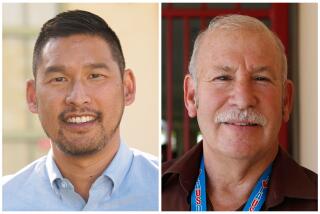School Bond Is Tougher Sell Now
- Share via
For the second time in five years, the Los Angeles Unified School District is seeking voter approval for a massive school construction bond issue to relieve campus overcrowding.
But the district’s plan to place a $3.3-billion measure on the November ballot is facing a much tougher political climate than prevailed the last time voters passed a school bond issue, officials say.
Municipal secession is threatening to split Los Angeles apart, and some San Fernando Valley separatists oppose the measure. Moreover, the school district faces enormous skepticism about how it handled proceeds from its previous bond issue, a $2.4-billion measure approved by voters in 1997.
District officials say the new bond money is needed to keep up with soaring enrollments, end mandatory busing and get already crowded schools off the worst year-round calendars.
Together with the 1997 funds, proceeds are expected to pay for 115 new schools and repair hundreds of other aging campuses.
“This city cannot survive without this solution,” said Supt. Roy Romer, who has asked actor Arnold Schwarzenegger and other celebrities to help promote the district’s message through public appearances or giving money. “There is no Plan B.”
L.A. Unified is gearing up for a multimillion-dollar publicity blitz to tout district successes and highlight the need for the bond issue. The measure must receive a 55% vote to pass. The previous ballot item, Proposition BB, passed five years ago with 71%. This time, the district must convince skeptical voters that it can do the job responsibly in the aftermath of disclosures that it mismanaged money for school repairs from Proposition BB. Public anger lingers too over how the district handled environmental problems at the Belmont Learning Complex near downtown.
The measure, scheduled to be approved next month by the Board of Education, will appear on the same ballot as a mammoth state school bond issue and the proposals for San Fernando Valley and Hollywood secession.
Secession would not affect the district’s boundaries, which are different from those of the city of Los Angeles and include several other cities and unincorporated areas.
But leaders of the breakaway effort are promoting a new Valley city as the first step toward creating a separate Valley school system--a district that they say would be more accountable to parents.
A key leader of the Valley secession movement says he will encourage voters to reject L.A. Unified’s bond issue, partly because of the problems with the last one.
“I think that putting this on the ballot is a wrong move in the midst of this tremendous grass-roots movement of Valley identity,” said Valley VOTE Chairman Richard Close. “I recognize the need for the facilities, but the timing is just wrong.”
Part of the dissent is fueled by distrust over how the school district handled spending for Proposition BB and the Belmont Learning Complex. That will be the costliest high school in California, with a price tag exceeding $260 million after an extended work stoppage and upcoming repairs to deal with dangerous gases at the site, part of which is a former oil field.
Romer disclosed last fall that the district faces a shortfall of as much as $600 million for repairs that Proposition BB originally was supposed to cover--the result of increasing costs, contractual disputes and poor oversight. Proposition BB, however, did launch several dozen new schools.
The district has finished half of about 12,000 repair and modernization jobs planned under Proposition BB and must now find money for the rest. Romer said the money will come not from the new bond issue but from developer fees, interest payments and other sources.
“People understand there is nothing like the value of a good education. The question is, can LAUSD deliver?” said former Assemblyman Richard Katz, a leader in the San Fernando Valley cityhood effort, who chaired the Proposition BB campaign five years ago. “Can they overcome all their lost opportunities, all the promises that were not met? That’s Romer’s challenge--to convince the public that their money will be well spent.”
District officials say they have now assembled a top-notch school facilities team that is up to the task. That team includes Jim McConnell, a former Navy Seabee; Kathi Littman, a construction management expert; and Tim Buresh, a highly regarded engineer who helped guide the $2.4-billion Alameda Corridor rail project.
Officials say they will develop detailed plans to set forth the scope of work and the costs and schedules of each project.
In addition, the school district is expanding the powers of a citizens committee to oversee Proposition BB and the new bond issue. The panel, with its own independent consultant and attorney, will issue monthly progress reports and early warnings when projects are likely to exceed budgeted costs.
District officials say that these measures go well beyond the oversight required by state law.
“The credibility of the organization to perform is what’s at stake here,” Romer said. “This is a different LAUSD than [the one of five years ago]. We now have the capacity to build this very large project on time and within budget.”
District leaders have already won over one former critic.
Attorney Robert Garcia, who heads the Proposition BB citizens committee, praised the district for “unprecedented cooperation” in sharing information about construction and repair progress, a big change from the secrecy he and others decried in the past.
“I have confidence that the new facilities team will build and repair schools wisely and efficiently, as the voters of Los Angeles intend,” Garcia told the school board this week.
L.A. Unified’s space crisis has been caused by steady enrollment growth and a failure to build enough schools. As a result, more than 17,000 students now ride buses from their crowded neighborhoods, some to campuses an hour away. And nearly half of the district’s 736,000 students attend schools year-round on staggered tracks that run 163 days--17 fewer than the school years at campuses on traditional calendars.
District officials say the new bond issue would help alleviate these problems, adding more than 112,000 classroom seats by 2006.
The Valley, which accounts for 30% of the district’s enrollment, would get 25% of the new seats; it would get additional classroom space as students bused to its schools returned to their own neighborhoods, officials said.
The district’s plans will depend on a $13-billion state bond issue, also on the November ballot, that will provide necessary matching funds. If either the state or local measure fails, the district’s plans will be thrown into disarray, officials warn.
“We will literally have kids with no place to sit, and that is an untenable position for our community,” said the school board president, Caprice Young.
The Los Angeles Unified bond measure would set aside $1.6 billion to complete 80 schools and 79 campus additions or playground expansions that were partly funded by Proposition BB.
An additional $1 billion would be used to build 35 more schools. These extra seats would allow the district to end mandatory busing and return all students to the 180-day calendars, the statewide standard--though most of these campuses would still have to operate on year-round schedules.
Aside from construction, the bond issue would devote $606 million to repair and modernize schools--replacing fire and burglar alarms, painting buildings and upgrading phone switches so 911 calls could be placed from classrooms.
Lesser amounts would be allocated to build more charter schools, expand early childhood centers, stock new campuses with library books and develop joint-use projects with other public agencies.
Young and Romer kicked off a fund-raising drive this week with an exclusive gathering of about 40 business and civic leaders at the private California Club downtown. In between crab cakes and wine, Romer solicited donations, telling guests that the district needs to raise $2 million for a successful bond campaign. He said the district had secured between $300,000 and $500,000 in pledges, with philanthropist Eli Broad and Disney chief Michael Eisner both indicating support.
Broad has given the district $100,000 to publicize its rising test scores and other successes, a district spokeswoman said.
*
Times staff writer Jessica Garrison contributed to this report.
More to Read
Sign up for Essential California
The most important California stories and recommendations in your inbox every morning.
You may occasionally receive promotional content from the Los Angeles Times.










